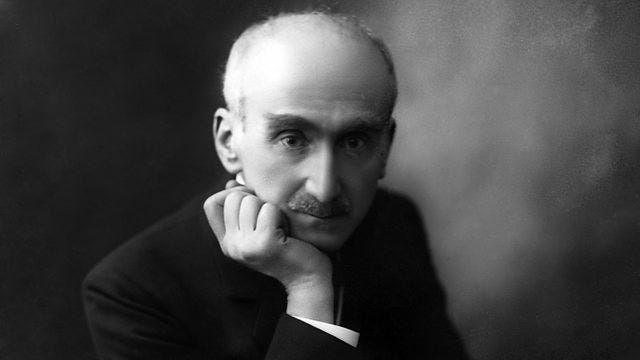I don’t like using the “B” word (biography). I prefer to say I am writing “a book about the life of Henri Bergson.” The reason is embarrassing: I find the very concept of biography intimidating. How do you capture a person’s whole existence in a few hundred pages? At least, if I am writing “about Bergson’s life,” I can circle in and out, explore tangents, and crucially, I don’t have to cover everything. That being said, some aspects of Bergson’s identity are unavoidable.
When I started the research for my book, I needed to get a sense of who Bergson was beyond his ideas. What was it like to be around him? What kind of impression did he make on those he met? I compiled every description of him I could find and, soon enough, interesting patterns started to emerge. Many of those who frequented the philosopher noted the musical cadence of his speech, others were disarmed by his almost pathological levels of humility or by the expressiveness of his light blue eyes. But all — and I mean every single person who committed a description of Bergson to paper — were struck by one of the philosopher’s features: his forehead.
Allow me to demonstrate:
Bergson’s forehead is repeatedly described as “enormous,” “powerful,” “huge.”
One of his former students writes:
"The forehead was the most striking thing about [Bergson], a broad, bulging forehead, which one might qualify as enormous when compared to his slender lower face".
Here is another how another person came to terms with the philosopher’s massive brow:
What was most striking about him was his very broad forehead, which extended the curve of his skull, and his blue eyes, sunken under thick eyebrows, extraordinarily expressive.
And my favourite:
The line of his eyebrows spread over the huge forehead like two metaphysical wings.
Since philosophers’ main activity is to think, and that in the West we tend to associate thinking, as well as consciousness in general, with the brain, it is perhaps not surprising that a philosopher’s skull would draw attention. After all, famous philosophers have been known to flex their foreheads:
However, the focus on Bergson’s forehead, and the brain hidden within, is somewhat ironic. In his second book, Matter and Memory, Bergson demoted the brain from organ of knowledge to a practical tool which evolved to allow us to navigate and act upon the material world. According to him, the brain was not the seat of consciousness nor was its function to create or store perceptions, memories and representations. Instead, it enabled organisms to link present stimuli with past perceptions and possible future outcomes. The brain could, in this regard, be compared to a “central telephone exchange”:
[I]ts office is to allow communication or to delay it. It adds nothing to what it receives.
The size of Bergson’s forehead, no matter how impressive, therefore had little to do with the subtlety of his thinking. But it appears to have had a lot to do with the strong impression the philosopher made on his hundreds of admirers. They could not help but read on the lines of face, in his luminous eyes, and on his gargantuan rounded skull, signs of their master’s genius.
There is a second reason I don’t like using the B-word: writing a biography of Bergson is a highly un-Bergsonian exercise. In the same way Bergson believed that examining someone’s brain would tell us nothing about their lived experience, he believed that studying someone’s life would do very little to inform us about their ideas.
But more about that in my book which I simply have to finish writing (no big deal, please stand by).
I recently published these slightly emo musings on my blog. If you enjoy my writing you might enjoy some of my other posts there.









Enjoyed reading your thoughts. 😊👍
I am SO looking forward to this book!